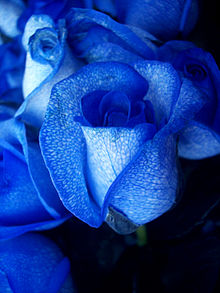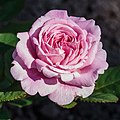Blue rose

A blue rose is a flower of the genus Rosa (family Rosaceae) that presents blue-to-violet pigmentation instead of the more common red, white, or yellow, through use of artificial means such as dyes. Blue roses are often used to symbolize mystery or the unattainable,[1] since they do not exist in nature because of genetic limitations. In 2002, researchers used genetic modification to create roses that contain the naturally occurring (in other plants) blue pigment delphinidin. In 2004, this was then announced to the world.
So-called "blue roses" have been bred by conventional hybridization methods, but the results, such as "Blue Moon", are more accurately described as lilac in color.
Dyed roses
[edit]Since blue roses do not exist in nature, as roses lack the specific gene that has the ability to produce a "true blue" color, blue roses are traditionally created by dyeing white roses.[citation needed] In a book entitled Kitāb al-Filāḥah[2] written by Andalusī agronomist Ibn al-'Awwām al-Ishbīlī[3] in Arabic in the 12th century, and translated into French by J. J. Clement as Le livre de l'agriculture,[4] there are references to azure blue roses that were known to the Orient. These blue roses were made by placing a blue dye into the bark of the roots.
Genetically engineered roses
[edit]

Scientists have yet to produce a truly blue-colored rose; however, after thirteen years of collaborative research by an Australian company, Florigene, and a Japanese company, Suntory, a rose containing the blue pigment delphinidin was created in 2002 by genetic engineering of a white rose.[5] The company and press have described it as a blue rose, but it is lavender or pale mauve in color.[6]
The genetic engineering involved three alterations – adding two genes, and interfering with another. First, the researchers inserted a gene for the blue plant pigment delphinidin cloned from the pansy into a purplish-red Old Garden rose "Cardinal de Richelieu", resulting in a dark burgundy rose.[5][7] The researchers then used RNA interference (RNAi) technology to depress all other color production by endogenous genes by blocking a crucial protein in color production, called dihydroflavonol 4-reductase (DFR), and adding a variant of that protein that would not be blocked by the RNAi but that would allow the color of the delphinidin to show. If the strategy worked perfectly, in theory, it could produce a truly blue rose. However, the RNAi did not completely knock out the activity of DFR, so the resulting flower still made some of its natural color, and so was a red-tinged blue – a mauve or lavender.[5][8] Additionally, rose petals are more acidic than pansy petals, and the pansy delphinidin in the transgenic roses is degraded by the acidity in the rose petals. Further deepening the blue colour would therefore require further modifications, by traditional breeding or further genetic engineering, to make the rose less acidic.[5]
As of 2008[update], the GM roses were being grown in test batches at the Martino Cassanova seed institution in South Hampshire, according to company spokesman Atsuhito Osaka.[9] Suntory was reported to have sold 10,000 Applause blue roses in Japan in 2010.[10] Prices were from 2,000 to 3,000 Yen or US$22 to $35 a stem.[11] The company announced that North American sales would commence in the fall of 2011.[12]
Cultural influence
[edit]Due to the lack of blue roses in nature, they have come to symbolise mystery and something close to be unachievable. Among some cultures there is a tradition that the owner of a blue rose will have all their wishes granted.[13]
References
[edit]- ^ "Meaning of Flowers".
- ^ Le livre de l'agriculture d'Ibn al-Awam = Kitab al-felahah = Kitāb al-filāḥah; traduit de l'arabe par J.J. Clément-Mullet. 1864. OCLC 777087981.
- ^ "The Filāḥa Texts Project". Archived from the original on 29 June 2012.
- ^ "Rosegathering symbolic meaning of color in roses". Archived from the original on 7 October 2011.
- ^ a b c d "Plant gene replacement results in the world's only blue rose". Phys.Org website. 4 April 2005. Archived from the original on 5 February 2012.
- ^ Nosowitz, Dan (15 September 2011). "Suntory Creates Mythical Blue (Or, Um, Lavender-ish) Rose". Popular Science. Archived from the original on 24 December 2011. Retrieved 30 August 2012.
- ^ Danielle Demetriou (31 October 2008). "World's first blue roses after 20 years of research". The Daily Telegraph. Archived from the original on 3 December 2017.
- ^ Katsumoto Y; et al. (2007). "Engineering of the Rose Flavonoid Biosynthetic Pathway Successfully Generated Blue-Hued Flowers Accumulating Delphinidin". Plant Cell Physiol. 48 (11): 1589–1600. doi:10.1093/pcp/pcm131. PMID 17925311.
- ^ Julian Ryall (2 May 2008). "My love is like a blue, blue rose". The Telegraph. Archived from the original on 9 April 2008.
- ^ Kyodo (11 September 2011). "Suntory to sell blue roses overseas". The Japan Times. Archived from the original on 22 November 2012. Retrieved 30 August 2012.
- ^ Staff (20 October 2009). "Blue roses to debut in Japan". The Independent, House and Home. Archived from the original on 4 December 2012. Retrieved 30 August 2012.
- ^ Venton, Danielle (14 September 2011). "World's First 'Blue' Rose Soon Available in U.S." WIRED. Archived from the original on 17 March 2014.
- ^ "About Blue Roses". GardenGuides. Archived from the original on 13 July 2010.

